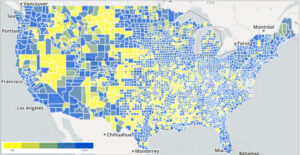Internet access is increasingly recognized as a “super determinant” of health. It plays a role in health care outcomes and influences more traditionally recognized social determinants of health, such as education, employment, and healthcare access.1,2 The Federal Communications Commission (FCC) estimates that 19 million people in the United States lack access to reliable broadband service, also known as reliable high-speed internet.3 This phenomenon is known as the digital divide and has focused on rural areas and “pockets of segregated urban areas [that] are also disconnected”.1
How the Digital Divide Intersects with Equity and Behavioral Health

This baseline map visualizes fixed broadband access at the county level and identifies connectivity gaps—the lighter the color, the lower the percentage of households with broadband access.
The nation’s digital divide reflects inequities in who can and cannot access high speed internet.4 The National Telecommunications and Information Administration (NTIA) reports that in 2021, wired high-speed internet use rates were lower in “households where the main renter or owner was 65 years or older, had a disability, or was a Hispanic, African American, American Indian, or Alaska Native individual”.4 Households in rural areas were less likely to use high-speed internet services and costs can make internet access unaffordable for individuals with lower household incomes.4 The American Health Information Management Association Foundation found that “while over 8 in 10 households with incomes above $100,000 used wired high-speed internet service at home, only about 5 in 10 households with incomes below $25,000 did in 2021”.4
